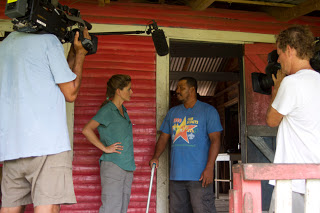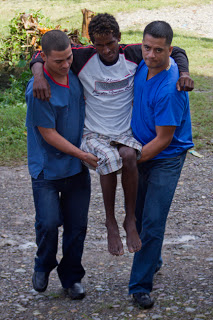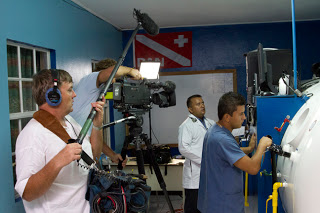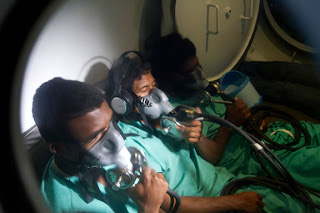I’ve been fortunate to see sharks on a few different dives. As most divers will attest, dives with sharks are much fewer than dives without them. They are amazing to watch. I’ve never had the opportunity to dive with Great Whites, but I would. I would do it for the same reason that I’ve taken photographs of lions and cheetahs, wild dogs and dingoes. They are apex predators. They are beautiful. And they are important. I see no difference between a lion on the African plain and a shark in the ocean.
Getting “made up” for International Television
Some of the earliest posts in this blog, and many posts since then, have talked about the situation of the lobster divers of Honduras and the work Dr. Elmer Mejia does in caring for those divers. I’m happy to say that the documentary project I created while working on my Certificate of Documentary Arts at the Center for Documentary Studies at Duke University has been used for background by the New York Times and NBC’s Rock Center with Brian Williams.
A couple weeks ago, a journalist from CCTV was in Honduras working with Dr. Mejia on her own story. Dr. Mejia recommended that she speak to me because I have been to Puerta Lempira (where the divers live) twice. After a number of phone calls and emails, we finally worked it out that I would head to Washington DC to be interviewed in their new studio for the show Americas Now. And that was how I ended up getting “made up” by a makeup artist before heading to the studio.
Never heard of CCTV before? It stands for China Central Television. At the beginning of February, they launched a new show called Americas Now from their still-under-construction studio in DC.
“CCTV America (as it contributes to global CCTV News) aims to inform, engage, and provide debate on a range of issues of relevance to American and global viewers with a particular interest in China and Asia. It aims to highlight coverage in underrepresented regions of the world with diversified perspectives and alternative views.
La Moskitia
(Day three of traveling with the NBC crew to tell the story of the Lobster Divers of Honduras.)
The Miskito Indians live in a region of Honduras and Nicaragua called La Moskitia, also known as the Mosquito Coast. It spans the far eastern end of both countries and the Indians pretty much ignore those borders. To get there, though, you have to fly or take a boat. There are no roads that lead from La Ceiba out to La Moskitia.
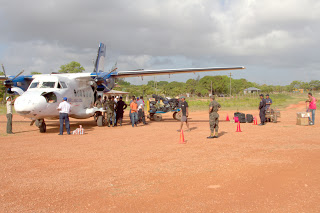 |
| Same airport, same plane, but this picture was taken on my first trip to La Moskitia. |
The plane is a small high wing puddle jumper…which was appropriate since it was the rainy season and we landed in the rain with mud puddles on the dirt air strip. The recurring theme of this trip was equipment. It took a while for the baggage handlers to get everything off the plane so the rest of the crew wandered around the “terminal” buildings for a few minutes. They were surprised that one of the first human beings they saw was a paralyzed diver in a wheel chair. He was sitting in the terminal making crafts for sale.
The Moskito Indians are the only Hondurans who dive for lobster. And their semi-isolation tends to keep them close together. This makes them easy to forget about until you land in Puerto Lempira. Then, injured and paralyzed divers are everywhere.
We went straight to the hotel and then got ready to go right back out. We took most of our gear with us. Later that afternoon, we were going to meet up with the boat that would take some of us out to see the divers in action.
Before we left the hotel, though, Natalie was able to interview the director of the lobster divers association. He was the first to say it, but not the last, that even though groups hold meetings and make promises, they have received nothing from those organizations, not even a pencil.
The director and assistant director of the diver’s association accompanied us on a small water taxi boat to Kaukira. That is one of the villages where many of the divers live. When we got there, we went to the home of Nelson, who would be our boat captain as well. We loaded into his truck with his wife driving and went off to visit divers at their homes.
At the first one, where I had been before, the people next door were drunk and began yelling at us to go home, saying that people come to La Moskitia and point their cameras but nothing ever gets done. He yelled most of the time we were there.
We visited a couple more homes, taking time to talk to the divers and listen to their life stories. Most of them were just trying to feed their families. They didn’t really understand the risks of diving, even though they all knew others who had been injured before them. Every family in Kaukira has a disabled diver in it.
As I said, we all piled into Nelson’s truck to visit the divers. I tend to identify more with the camera guys, so I jumped in the bed of the truck with them. I was seated on the tailgate, with my camera up to my face most of the time. When we hit one deep rut in the dirt road, the rusted-through cable that held up the tailgate broke, nearly sending me crashing into the mud. Fortunately, Dr. Mejia was sitting beside me talking and he grabbed my arm to steady me while the camera crew yelled for the driver to stop.
When it was finally time to go to the boat, we cut straight across the peninsula, rather than going back around to the roads. We drove through a swamp and then came out on the beach where we met a small boat that took us through the surf to get to the large boat.
As soon as we got on the boat we knew there was a problem. It was old and run down and there was no bathroom. Space was very tight and there were only 5 bunks. We had 10 people with a crew of 6.
Another day, another diver
(This is the second installment of the behind-the-scenes account of traveling with the NBC crew for the Rock Center story.)
Monday morning dawned early for most of us. The time difference was two hours then (daylight savings time was still on) so even though most of us wanted to sleep to be.
This treatment was the 596th time Dr. Mejia had run a treatment since opening the clinic. He averages seven treatments per patient; often multiple divers are in the chamber at the same time. While Dr. Mejia sees the most severe patients, almost always with some level of paralysis and often with bladder control issues, he has had tremendous success. He has an 81 percent success rate of divers leaving the chamber under their own power. Often they need a cane or a walker, but they are in much better shape than when they arrived.
What still amazes me is that Dr. Mejia only charges about $300 US per diver. That is for all his care, not per treatment. Care includes treatment, food, lodging, physical therapy, any tests he has to run. Dr. Mejia doesn’t charge the divers. He charges the boat owners, although sometimes they won’t pay. He is reluctant to raise his prices any, however, as he is afraid the boat owners will refuse to pay, or worse will skip treatment all together.
Working With NBC
A little more than a year ago, NationalGeographic.com profiled the problems with the lobster divers in Honduras; they used several of my photographs and quoted Dr. Matias Nochetto from DAN and I about the issue as we were both working on the Harvesting Diver Project.
Tomorrow, I will post about our first full day on the ground in San Pedro Sula. Stay tuned..
- « Previous Page
- 1
- …
- 24
- 25
- 26
- 27
- 28
- …
- 34
- Next Page »




